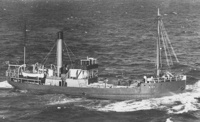The steel twin screw steamship Uki was built by Lithgows Ltd of Glasgow, Scotland, for service in the northern New South Wales coastal river trade and named after the northern New South Wales town of Uki in the Tweed Valley.
It was requisitioned in Sydney from its owners, the North Coast Steam Navigation Company, for naval service on 3 November 1939.
The following day it departed for Melbourne to be fitted out as an auxiliary minesweeper. It commissioned in Melbourne as HMAS Uki on 11 December 1939 under the command of Lieutenant Maurice Boyd RANR(S).
Uki departed Melbourne on 15 January 1940 arriving in Newcastle 4 days later where it took up duty as a unit of Minesweeping Group 77. For most of the next 2 years, Uki, along with 6 other auxiliary minesweepers based in Newcastle and Sydney, conducted minesweeping off the New South Wales coast, maintaining a clear channel 25 nm offshore.
By the end of 1941, 73 German mines had been located in Australian waters. Most were destroyed at sea by rifle fire or were dealt with by the Rendering Mines Safe section after being washed ashore.
On 17 November 1941, Uki departed Newcastle to join Minesweeping Group 54 based in Melbourne. Two days later, the crew sighted a German mine off Montagu Island on the New South Wales south coast, hoisted it on deck and returned it to port for further examination. It arrived in Williamstown on 23 November where it continued minesweeping operations until the end of 1942.
Uki decommissioned in Melbourne on Christmas Eve 1942 and was transferred to the United States Navy for service as a stores carrier in Queensland waters. It was transferred back to the RAN on 29 September 1944 and returned to its owners on 27 October 1944.
Uki returned to the coastal trade postwar until the North Coast Steam Navigation Company ceased operations in 1954. It was subsequently sold to M Bern & Co and used as a gravel barge on the Brisbane River before being scuttled as a breakwater off Tangalooma, Moreton Bay, in June 1976.
Specifications
 |
| Pennant |
FY80 |
|---|---|
| Builder |
Lithgows Ltd, Port Glasgow, Scotland |
| Commissioned |
11 December 1939 |
| Decommissioned |
24 December 1942 |
| Fate |
Returned to owners 27 October 1944 |
| Dimensions & Displacement | |
| Displacement | 545 tons |
| Length | 153 feet |
| Beam | 34 feet |
| Draught | 8 feet 6 inches |
| Performance | |
| Speed | 9 knots |
| Complement | |
| Crew | 28 |
| Propulsion | |
| Machinery | Triple expansion |
| Horsepower | 70 |
| Armament | |
| Guns |
|
| Other Armament | 2 depth charge chutes |
